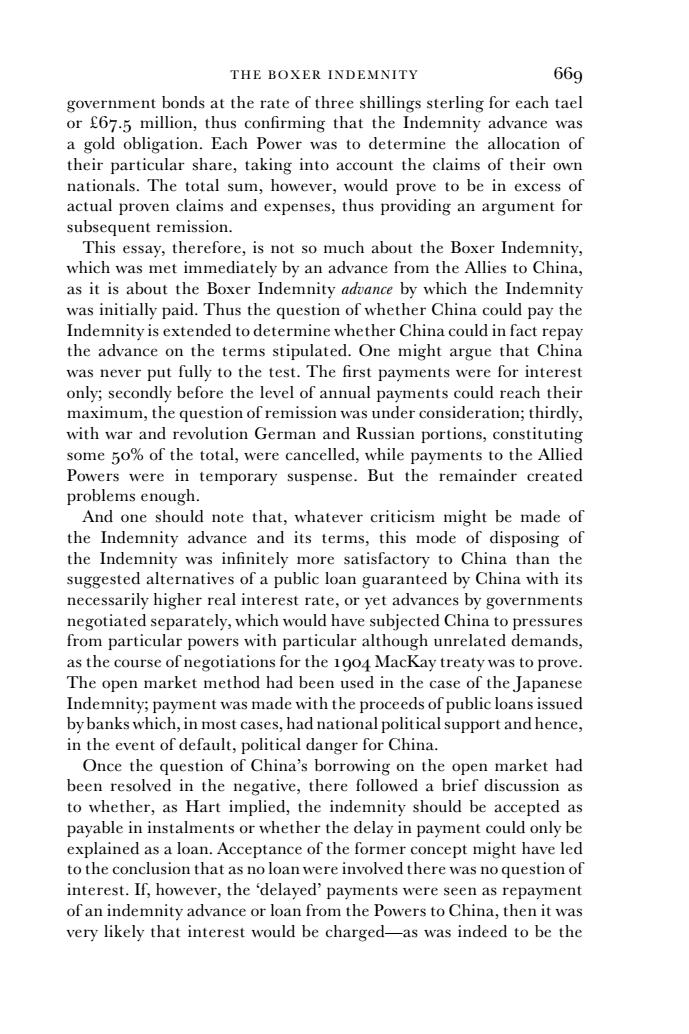正在加载图片...

THE BOXER INDEMNITY 669 government bonds at the rate of three shillings sterling for each tael or f67.5 million,thus confirming that the Indemnity advance was a gold obligation.Each Power was to determine the allocation of their particular share,taking into account the claims of their own nationals.The total sum,however,would prove to be in excess of actual proven claims and expenses,thus providing an argument for subsequent remission. This essay,therefore,is not so much about the Boxer Indemnity, which was met immediately by an advance from the Allies to China, as it is about the Boxer Indemnity advance by which the Indemnity was initially paid.Thus the question of whether China could pay the Indemnity is extended to determine whether China could in fact repay the advance on the terms stipulated.One might argue that China was never put fully to the test.The first payments were for interest only;secondly before the level of annual payments could reach their maximum,the question of remission was under consideration;thirdly, with war and revolution German and Russian portions,constituting some 50%of the total,were cancelled,while payments to the Allied Powers were in temporary suspense.But the remainder created problems enough. And one should note that,whatever criticism might be made of the Indemnity advance and its terms,this mode of disposing of the Indemnity was infinitely more satisfactory to China than the suggested alternatives of a public loan guaranteed by China with its necessarily higher real interest rate,or yet advances by governments negotiated separately,which would have subjected China to pressures from particular powers with particular although unrelated demands, as the course of negotiations for the 1904 MacKay treaty was to prove. The open market method had been used in the case of the Japanese Indemnity;payment was made with the proceeds of public loans issued by banks which,in most cases,had national political support and hence, in the event of default,political danger for China. Once the question of China's borrowing on the open market had been resolved in the negative,there followed a brief discussion as to whether,as Hart implied,the indemnity should be accepted as payable in instalments or whether the delay in payment could only be explained as a loan.Acceptance of the former concept might have led to the conclusion that as no loan were involved there was no question of interest.If,however,the 'delayed'payments were seen as repayment of an indemnity advance or loan from the Powers to China,then it was very likely that interest would be charged-as was indeed to be theTHE BOXER INDEMNITY 669 government bonds at the rate of three shillings sterling for each tael or £67.5 million, thus confirming that the Indemnity advance was a gold obligation. Each Power was to determine the allocation of their particular share, taking into account the claims of their own nationals. The total sum, however, would prove to be in excess of actual proven claims and expenses, thus providing an argument for subsequent remission. This essay, therefore, is not so much about the Boxer Indemnity, which was met immediately by an advance from the Allies to China, as it is about the Boxer Indemnity advance by which the Indemnity was initially paid. Thus the question of whether China could pay the Indemnity is extended to determine whether China could in fact repay the advance on the terms stipulated. One might argue that China was never put fully to the test. The first payments were for interest only; secondly before the level of annual payments could reach their maximum, the question of remission was under consideration; thirdly, with war and revolution German and Russian portions, constituting some 50% of the total, were cancelled, while payments to the Allied Powers were in temporary suspense. But the remainder created problems enough. And one should note that, whatever criticism might be made of the Indemnity advance and its terms, this mode of disposing of the Indemnity was infinitely more satisfactory to China than the suggested alternatives of a public loan guaranteed by China with its necessarily higher real interest rate, or yet advances by governments negotiated separately, which would have subjected China to pressures from particular powers with particular although unrelated demands, as the course of negotiations for the 1904 MacKay treaty was to prove. The open market method had been used in the case of the Japanese Indemnity; payment was made with the proceeds of public loans issued by banks which, in most cases, had national political support and hence, in the event of default, political danger for China. Once the question of China’s borrowing on the open market had been resolved in the negative, there followed a brief discussion as to whether, as Hart implied, the indemnity should be accepted as payable in instalments or whether the delay in payment could only be explained as a loan. Acceptance of the former concept might have led to the conclusion that as no loan were involved there was no question of interest. If, however, the ‘delayed’ payments were seen as repayment of an indemnity advance or loan from the Powers to China, then it was very likely that interest would be charged—as was indeed to be the